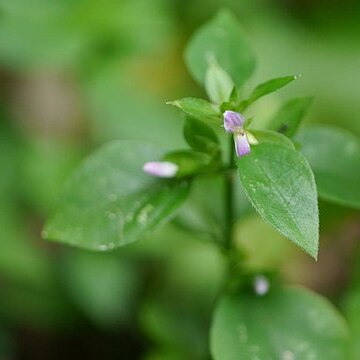Herbs 30-80 cm tall, annual or biennial. Stems ridged, basally diffuse, apically erect, glabrous except for pubescence on young branches and nodes. Petiole to 0.5-3 cm, puberulent; leaf blade ovate-elliptic, 2-8 × 1.5-4 cm, abaxially sparsely puberulent along veins, adaxially glabrous, secondary veins 4 or 5 on each side of midvein and abaxially slightly prominent, base cuneate to attenuate and decurrent onto petiole, margin entire or slightly sinuate, apex shortly acuminate to acute. Inflorescences each of (1-)3 or 4 pedunculate cymes from upper leaf axils, 1-4 cm; inflorescence bracts subulate to linear to oblanceolate to obovate, 3-7.5 × 0.3-1 mm; peduncle 2-5 mm; cymules usually 3 or 4 per cyme; outer bracteoles elliptic to obovate, 5-13 × 3-8 mm, unequal, abaxially puberulent, 3-veined, margin ciliate, apex acute and mucronate; inner bracteoles linear, ca. 5 mm, abaxially hirsute, apex acuminate. Pedicel 0.5-3 mm, puberulent. Calyx ca. 5 mm; lobes linear, equal, margin hirsute, apex acuminate. Corolla pale purple, 1-1.2 cm, outside puberulent; tube slender, ca. 6 mm, ca. 1.5 mm wide; limb 2-lipped; lip in lower position ovate, ca. 5 × 3 mm, apex entire; lip in upper position oblong, ca. 4 × 1.5 mm, shallowly 3-lobed. Stamens inserted near apex of corolla tube; filaments ca. 4 mm, glabrous; thecae spherical, ca. 1.2 mm in diam., parallel. Ovary pilose at tip; style ca. 1.4 cm. Capsule broadly ellipsoid, ca. 6 mm, puberulent, 4-seeded, apex apiculate. Seeds circular in outline, ca. 2 mm in diam., covered with apically barbed papillae. Fl. Sep-Jan, fr. Nov-Feb. 2n = 26.
More
A herb. It keeps growing from year to year. It grows 30-50 cm high. It has soft hairs. The leaves are narrowly oval and 3-5 cm long by 1-3 cm wide. They taper to a short tip. The flowers are pink-purple and small. They do not have stalks. They are in groups in the axils of leaves.

